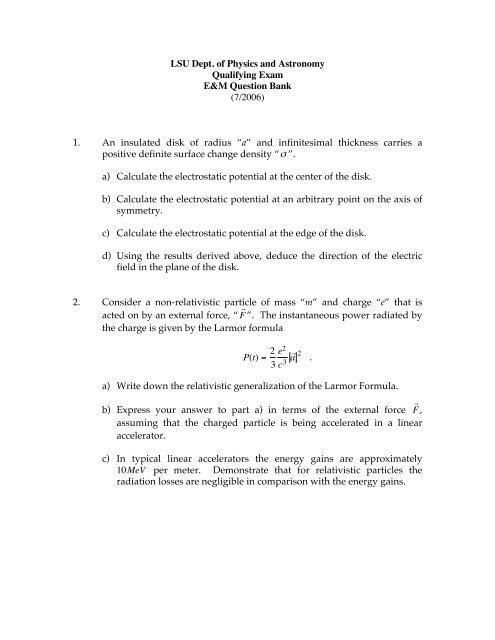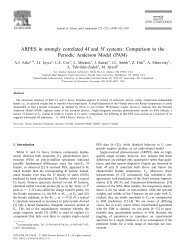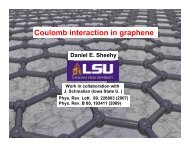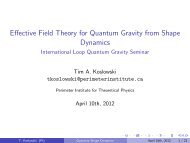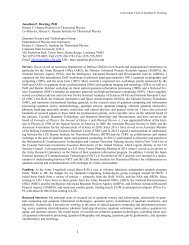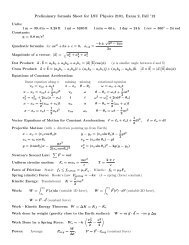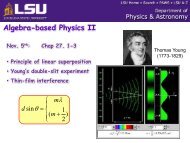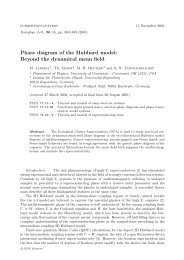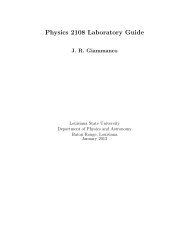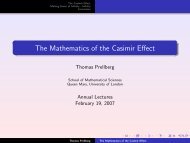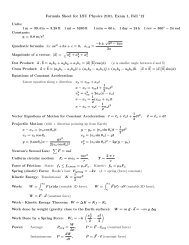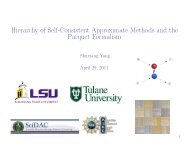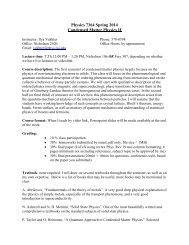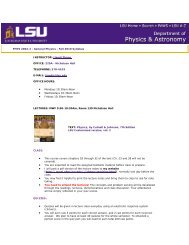Electricity and Magnetism - Department of Physics & Astronomy
Electricity and Magnetism - Department of Physics & Astronomy
Electricity and Magnetism - Department of Physics & Astronomy
Create successful ePaper yourself
Turn your PDF publications into a flip-book with our unique Google optimized e-Paper software.
LSU Dept. <strong>of</strong> <strong>Physics</strong> <strong>and</strong> <strong>Astronomy</strong>Qualifying ExamE&M Question Bank(7/2006)1. An insulated disk <strong>of</strong> radius “a” <strong>and</strong> infinitesimal thickness carries apositive definite surface change density “σ ”.a) Calculate the electrostatic potential at the center <strong>of</strong> the disk.b) Calculate the electrostatic potential at an arbitrary point on the axis <strong>of</strong>symmetry.c) Calculate the electrostatic potential at the edge <strong>of</strong> the disk.d) Using the results derived above, deduce the direction <strong>of</strong> the electricfield in the plane <strong>of</strong> the disk.2. Consider a non-relativistic particle <strong>of</strong> mass “m” <strong>and</strong> charge “e” that isacted on by an external force, “ F ”. The instantaneous power radiated bythe charge is given by the Larmor formulaP(t) = 2 3e 2c 3 a 2 .a) Write down the relativistic generalization <strong>of</strong> the Larmor Formula.b) Express your answer to part a) in terms <strong>of</strong> the external force F ,assuming that the charged particle is being accelerated in a linearaccelerator.c) In typical linear accelerators the energy gains are approximately10MeV per meter. Demonstrate that for relativistic particles theradiation losses are negligible in comparison with the energy gains.
3. The angular distribution <strong>of</strong> radiation from an accelerated charge is givenbydP( t ′)dΩ= e24πcn ˆ ×{( n ˆ − β ) × β˙} 21− n ˆ ⋅ β( ) 5where t ′ denotes the retarded time <strong>and</strong> n ˆ is a unit vector that points fromthe charge to the observation point.a) Consider linear motion for which β <strong>and</strong> ˙β point in the same direction.Let θ denote the angle between n ˆ <strong>and</strong> the common direction <strong>of</strong> β <strong>and</strong> ˙β . Reduce the expression shown above to a simpler form that is validfor this situation.b) As β → 1, the radiation is confined to a very narrow cone about thedirection <strong>of</strong> motion. In this limit calculate the angular distribution <strong>of</strong>the radiation from your answer to part a).c) Let θ max denote the angle at which the intensity <strong>of</strong> radiation reaches itsmaximum value. As β → 1, θ max → 1 2γ , <strong>and</strong> the maximal intensity isproportional to γ n , where “n” denotes a real number. Derive the value<strong>of</strong> “n”.4. Consider a simple model for a dielectric in which the atomic electrons arebound to a fixed site by means <strong>of</strong> a harmonic restoring force −ω2 o x .Suppose that in addition the electrons are acted upon by a damping force−γ o x ˙ . This simple model leads immediately to the following expressionfor ε(ω) :ε(ω) = 1+ 4πNe2m1ω o 2 −ω 2 − iωγ owhere N is the number <strong>of</strong> electrons per unit volume.If we consider the limit in which ω o → 0 , then the atomic electrons are nolonger bound to a fixed site, <strong>and</strong> the simple model reduces to a model forconductivity. Use the expression shown above to derive σ(ω) in the limitthat ω o → 0 .
8. Consider the following relativistic transformations.a) Suppose that the electric field E , has Cartesian componentsE x , E y , E z in an inertial frame K <strong>and</strong> that the magnetic field is zero.Write down an expression showing how their corresponding valuesE x ′, E y ′, E z ′ may be calculated in any other inertial frame K ′.b) Consider the special case <strong>of</strong> an inertial frame K ′ that is moving in thepositive x direction with a velocity v, as viewed from an inertial frameK. The 4-coordinates x µ in K <strong>and</strong> ( x ′) v in K ′ (where, as ususal,µ,ν = 0,1,2,3) are related by a Lorentz transformation matrix. Writedown this matrix.c) For the specific transformation discussed in (b), calculate E x ′, E y ′, E z ′ .9. The plates <strong>of</strong> a semi-infinite capacitor are maintained at a constantpotential difference V by means <strong>of</strong> a battery. The plates are a distance dapart. A charge q <strong>of</strong> mass m is released from rest at the surface <strong>of</strong> oneplate <strong>and</strong> moves toward the other plate under the influence <strong>of</strong> the electricfield. Ignoring complicating effects, such as gravity <strong>and</strong> image changes,(a) derive an expression for the power radiated by the charge during itsmotion.(b) calculate the total energy radiated by the charge during its motion <strong>and</strong>compare with the change in kinetic energy.(c) identify any assumptions that underlie your calculation.NOTE: The results in (a) <strong>and</strong> (b) should be expressed in terms <strong>of</strong> q, m, V,d <strong>and</strong> c (velocity <strong>of</strong> light).10. For a single cylindrical wave-guide, the solution <strong>of</strong> the wave equationfor E may be written in the form E ( x, y, z, t) = E ( x, y) e ±ikz−iωt .Also, for a TM wave, the z component <strong>of</strong> field E is zero on theboundary, (i.e. on the cylinder). Show, from general considerations,that there is a cut-<strong>of</strong>f frequency for the propagation <strong>of</strong> waves.11. Consider a general current distribution J ( x ′) localized in a small region <strong>of</strong>space.(a) Define the associated magnetic moment m .
(b) Write down a general result for the vector potential A ( x ) in terms <strong>of</strong>J ( x ′) (1 point) <strong>and</strong> use it to write down (pro<strong>of</strong> not required) anexpression for A ( x ) in terms <strong>of</strong> m in the case where x >> x ′ .(c) Assuming that a magnetostatic field is due entirely to a localizeddistribution <strong>of</strong> permanent magnetization, show that∫ B ⋅ H dx = 0where the integral is taken over all space.12. A plane polarized electromagnetic wave <strong>of</strong> frequency ω in free space isincident normally on the flat surface <strong>of</strong> a nonpermeable medium <strong>of</strong>conductivity σ <strong>and</strong> dielectric constant ε.(a) Given that the ratio <strong>of</strong> the amplitudes <strong>of</strong> the reflected <strong>and</strong> incidentwaves isE o"E o= 1 − nn +1 ,where n is the refractive index, <strong>and</strong> that we are dealing with a goodconductor, derive the Hagen-Rubens relation for the reflectivity.(b) Assumingthat the conductivity <strong>of</strong> sodium is 2.1 ×10 17its reflectivity at a wavelength <strong>of</strong> 10 microns.s −1 , calculate13. One <strong>of</strong> the two cases below is an unphysical electrostatic field. (Do notassume that electric charge density is zero.) :case 1) E = k[ xyx + 2yzy + 3 xzz]case 2) E = k[ y + ( xy + z ) + yz ]2 x 2 2 y 2 z where k is an arbitrary constant with the appropriate units.(a) Show explicitly why each case is a physical or unphysical electrostaticfield.(b) For the physical case, find the associated electrostatic potential V ,using the origin as the reference point. Check your answer bycomputing ∇ V .
14. A square "loop" has been cut out <strong>of</strong> a sheet <strong>of</strong> aluminum. It is then placedso that the top portion is in a uniform magnetic field B (shaded in thediagram below), <strong>and</strong> is allowed to fall under gravity.Calculate the terminal velocity <strong>of</strong> this loop, in meters/second, given B = 1Tesla, the resistivity <strong>of</strong> Aluminum = 2.65 ×10 −8 Ω ⋅ m , <strong>and</strong> g = 9.8m s 2 .15. The sides <strong>of</strong> a half-infinite square metal pipe (sides a ) are grounded (V = 0). Theend, at x = 0 , is maintained at a specified constant electric potential V 0, as shownin the figure below.ayV=V 0axza) Find the potential inside the pipe, for x ≥ 0. (Hint: the st<strong>and</strong>ard solution is aninfinite series.)b) Use the result above to find the actual value <strong>of</strong> the electric field in the middle<strong>of</strong> the pipe, y = z = 0.5a, at a distance x = 4a from the end, where a = 10 -2 meter<strong>and</strong> V 0 = 1 Volt. (Hint: the first two or three terms in the series should providesufficient accuracy.)16. A rocket flies through a building with doors at each end, traveling withvc = β = + 12relative to the building. The building is 5 meters long, so in its rest13frame we can assign x = 0 as the position <strong>of</strong> the back door <strong>and</strong> x = 5 as theposition <strong>of</strong> the front door.Consider these four events:1) front <strong>of</strong> rocket enters the back door
2) front <strong>of</strong> rocket exits the front door3) back <strong>of</strong> rocket enters the back door4) back <strong>of</strong> rocket exits the front doorIt is observed that events 2) <strong>and</strong> 3) are simultaneous, in the rest frame <strong>of</strong> thebuilding at t = 0, so at this moment the rocket just fits inside the building, i.e. therocket is measured to be 5 meters long in this frame.a) Draw a space-time diagram for this situation approximately to scale, showing theworld-lines for the front <strong>and</strong> back <strong>of</strong> the rocket <strong>and</strong> the front <strong>and</strong> back <strong>of</strong> thebuilding. Do this in the rest frame <strong>of</strong> the building <strong>and</strong> locate <strong>and</strong> label the fourevents.b) Calculate the proper length <strong>of</strong> the rocket.c) Draw the same type <strong>of</strong> space-time diagram as in part a), but now in the rest frame<strong>of</strong> the rocket.d) How long is the building, when measured in the rest frame <strong>of</strong> the rocket?17. Calculate the capacitance C <strong>of</strong> a spherical capacitor <strong>of</strong> inner radius R 1 <strong>and</strong> outer radius R 2filled with a dielectric given bywhere θ is the polar angle.ε = ε 0 + ε 1 cos 2 θ18. A toroidal winding <strong>of</strong> N turns encloses a doughnut-shaped ferromagnetic ring witha small gap <strong>of</strong> width x as shown in the figure. Consider the gap to be sufficientlysmall so that fringing fields can be neglected. The mean radius <strong>of</strong> the toroid is r<strong>and</strong> a steady current <strong>of</strong> I flows in the winding. The relative permeability <strong>of</strong> theferromagnetic material is km (Note: the permeability is in general a function <strong>of</strong> theapplied field).Ixa) Determine the ratio <strong>of</strong> the magnetic field in the gap, Hg, to the magnetic fieldinside the ferromagnetic material, Hi.
) Both the field in the gap <strong>and</strong> the current in the winding can be measured.Develop an expression for the permeability <strong>of</strong> the material in terms <strong>of</strong> thesemeasured quantities <strong>and</strong> the geometry <strong>of</strong> the toroid.19. Consider a single frequency plane wave incident on a charge q bound in aclassical harmonic potential. For the plane wave:E x = E o cos(kz - vt)where v = kc.Assume that the restoring force on the charge is equal to - mv o 2 x <strong>and</strong> that there isa resistive force proportional to the velocity <strong>of</strong> the charge, g(dx/dt). Determine anexpression for the scattering cross section for this charge as a function <strong>of</strong> thefrequency <strong>of</strong> the incoming wave.20. Starting from the LaGrangian for a charged particle in an electromagnetic fieldL = (1/2)mv 2 – q(V - v·A)derive the equation <strong>of</strong> motion for the particle in ordinary Newtonian form.21. A chargeQ is situated at (2a, 0, 0) <strong>and</strong> a charge 2Q is situated at (-a, 0, 0).(a) Identify every point in space where the electric field E is zero.€ (b) Consider two concentric metal (conducting) spheres, <strong>of</strong> radii R 1 <strong>and</strong> R 2carrying total charges Q 1 <strong>and</strong> Q 2 respectively. What is the potential <strong>of</strong> theouter sphere, the inner sphere <strong>and</strong> inside inner sphere .22. (a) Write down the macroscopic Maxwell’s equation in MKS units.(b)(c)(d)State which are the fundamental fields.Derive the transformation properties <strong>of</strong> E , D , <strong>and</strong> B under spaceinversion P <strong>and</strong> time reversal T.If magnetic monopoles were shown to exist would this have anyconsequence for the nature <strong>of</strong> electric charge?23. The vector potential for a given currentdistribution with a sinusoidal time dependenceJ(x,t) = J ω (x)e −ωt is given by:A ω (x) = 1 J ωc∫ ( x ′) Rx− x ′eikx − x ′d 3 x ′ ,dRJ≠0
where k = ω c B ω = ∇ × A ω , <strong>and</strong> E ω = i k ∇ × B ω .There are three length scales to consider:1. d : size <strong>of</strong> the region where J ω ( x ′) ≠ 0.2. λ : = 2π / k = 2πc / ω .3. r : distance <strong>of</strong> the observation point from the current.Derive the following electric dipole radiation field expressions justifyingeach approximation with relevant conditions e.g. (length scale) 1
25. A parallel plate capacitor has a composite dielectric filling as shown in thefigure.Area "A"d1ε 1d2ε 2a) Derive an expression for its capacitance.b) A parallel plate capacitor is formed with two metal plates 10 cm by 10cm separated by an air space 4 mm wide. The capacitor is charged froma 400 V supply. Then, the supply is disconnected <strong>and</strong> immediately asheet <strong>of</strong> glass 10 cm by 10 cm by 2 mm is placed midway between theplates.i) Calculate the capacitance <strong>of</strong> the capacitor with <strong>and</strong> without theglass, for which ε 2 = 6 .ii) Calculate the potential difference across the capacitor afterinserting the glass.iii) Calculate the stored energy, before <strong>and</strong> after inserting the glassplate <strong>and</strong> explain any difference.26. The electric potential just outside <strong>of</strong> the surface <strong>of</strong> a dielectric sphere <strong>of</strong>radius a, dielectric constant ε , <strong>and</strong> fixed surface charge density σ isφ = A Y 2,0 (θ,φ) = A516π (3cos2 θ −1)a) Find the electric potential everywhere outside the sphere.b) Find the electric potential everywhere inside the sphere.c) Determine the surface charge density σ .
27. A ray <strong>of</strong> light is incident upon the bottom surface <strong>of</strong> a dielectric slab asillustrated below. The index <strong>of</strong> refraction is not constant but rather asmooth, differentiable function <strong>of</strong> x, n(x) .a) Derive an expression for the angle between the trajectory <strong>and</strong> thenormal as a function <strong>of</strong> x for 0 ≤ x ≤ L (10 pts.).b) Derive an integral expression for the magnitude <strong>of</strong> the lateraldisplacement <strong>of</strong> the ray, denoted by “Δ ” in the diagram below (10pts.).c) Derive a relation between θ e<strong>and</strong> θ i(5 pts.).θ en=1Δx=Ln(x)Lxx=0yn=1θ i28. Answer briefly <strong>and</strong> to the point.
a) What is Cherenkov radiation <strong>and</strong> what condition is necessary to obtainit?b) What is Thomson scattering? How does it differ from Comptonscattering?c) What is the difference, if any, between cyclotron radiation <strong>and</strong>synchrotron radiation?d) There have been 3 different frequencies <strong>of</strong> choice used for transmission<strong>of</strong> light by optical fibers. What are these frequencies <strong>and</strong> why werethey chosen <strong>and</strong> in some cases, later fell out <strong>of</strong> favor?e) Describe briefly in words the 3 sources <strong>of</strong> intrinsic losses in opticalfibers <strong>and</strong> the wavelengths region where they predominate.29. A sphere <strong>of</strong> radius “R” is constructed <strong>of</strong> an imperfect conductor; that is,the conductivity σ is a non-zero, non-infinite constant. Initially the sphereis uncharged, but at time t = 0 a charge “Q” is deposited at the center <strong>of</strong>the sphere.(a) Calculate the rate at which the charge at the center <strong>of</strong> the spheredecays. Identify the decay constant.(b) Prove that the charge density ρ( r ,t) = 0 for all r that satisfy theinequality 0 < | r | < R.(c) Calculate the rate at which charge accumulates on the outer surface <strong>of</strong>the sphere.(d) Compare your answers to parts (a) <strong>and</strong> (c) <strong>and</strong> comment as necessary.30. Two charges, +q <strong>and</strong> –q, are attached to the ends <strong>of</strong> a rigid rod. The rodrotates about the z-axis with an angular frequency ω.(a) Calculate the radiated power if the two charges are regarded asindependent <strong>and</strong> uncorrelated.(b) Calculate the radiated power if the two charges are regarded as asingle indivisible physical system.(c) Compare your answers to parts (a) <strong>and</strong> (b) <strong>and</strong> comment as necessary
31. A long coaxial cable carries current I. The current flows down the surface <strong>of</strong> theinner cylinder (<strong>of</strong> radius a) <strong>and</strong> back along the outer cylinder (<strong>of</strong> radius b).a) Calculate the self-inductance <strong>of</strong> the cable.b) Calculate the power (energy per unit time) transported down the wire.c) Assume the two conductors are held at potential difference V <strong>and</strong> carry currentI in opposite directions. Show that P = IV.32. Suppose you had an electric charge q e <strong>and</strong> a magnetic monopole q m . The field <strong>of</strong>the electric charge isqE = 1 erˆ24πε 0 r,<strong>and</strong> the field <strong>of</strong> the magnetic monopole isµ0qB = mrˆ.24πrFind the total angular momentum stored in the fields, if the two charges areseparated by a distance d.33. A TEM mode propagates along a transmission line that consists <strong>of</strong> two long thin parallelstrips <strong>of</strong> conductor <strong>of</strong> width b <strong>and</strong> separation d (d =µ dε 2bI o2where I o is the total current flowing in one conductor.34 An infinite straight wire lies along the z-axis. The wire is neutral <strong>and</strong> carries a currentthat increases linearly in time:I(t) =⎧0for t < 0⎨⎩ktfor t ≥ 0wherek> 0 .What are the fields E(t) <strong>and</strong> B(t) at a distance d from the wire?
dz2 2Hint : ∫ = ln( z + z + d ).2 2d + z35. Why is the sky blue? Part <strong>of</strong> the answer is as follows:a) Sunlight passing through the atmosphere causes individual atoms to oscillate likedipoles. The oscillating dipoles absorb the incident light <strong>and</strong> re-emit it. If the amplitude<strong>of</strong> the dipole displacement from equilibrium is x o under the influence <strong>of</strong> light <strong>of</strong>frequency ν = ω/2π, what is the power <strong>of</strong> the re-radiated light from a single dipole?b) If the incident solar radiation had equal intensity in the blue <strong>and</strong> red regions <strong>of</strong> thespectrum, what would be the ratio <strong>of</strong> re-emitted blue light to re-emitted red light?36. Determine the threshold kinetic energies fora) π meson production in nucleon-nucleon collisions. Assume m π /M nucleon = 0.15 <strong>and</strong>work in the lab frame where an incoming beam nucleon strikes a stationary targetnucleon. Give your answer in terms <strong>of</strong> MeV.b) Nucleon pair production in electron-positron collisions. Again give the result in thelab frame, where now the electrons <strong>and</strong> positrons are produced in colliding beams <strong>of</strong>equal energy. Give your answer in terms <strong>of</strong> GeV.37. A π meson (m 1c 2 = 140 MeV) collides with a stationary target proton (m 2c 2 = 938 MeV)to create a K meson (m 3c 2 = 494 MeV) <strong>and</strong> a lambda hyperon (m 4c 2 = 1115 MeV). Finda) the kinetic energy in MeV <strong>of</strong> the incident π meson at threshold for production <strong>of</strong> Kmesons,b) the kinetic energy <strong>of</strong> the π meson in MeV in order to create K mesons at 90° in thelaboratory, <strong>and</strong>c) the kinetic energy <strong>of</strong> the K mesons at 90° in the lab when the incident π has a kineticenergy <strong>of</strong> 1500 MeV.38. Inertial system S' moves at constant velocity v = βc (cos φ xˆ + sin φ ŷ ) with respect toinertial frame S. Their axes are parallel, <strong>and</strong> their origins coincide at t = t' = 0. Find theLorentz transformation matrix from S to S'.39. The xy plane forms the boundary between two non-magnetic linear media, medium 1 tothe left with index <strong>of</strong> refraction n 1 , <strong>and</strong> medium 2 to the right with index n 2 . A plane wave
traveling in the z direction is polarized along the x axis. What is the ratio <strong>of</strong> reflectedintensity to incident intensity, <strong>and</strong> what is the ratio <strong>of</strong> transmitted intensity to incidentintensity?40. In the Bohr hydrogen atom, the electron in its ground state travels in a circle <strong>of</strong> radius 5 x10 -11 m, held in orbit by the Coulomb attraction <strong>of</strong> the proton. The mass <strong>of</strong> the electron is9.11 x 10 -31 kg, the electron charge is 1.6 x 10 -19 C, <strong>and</strong> ε o = 8.85 x 10 -12 C/N m 2 .a) Show that the orbital velocity <strong>of</strong> the electron is non-relativistic.b) According to classical electrodynamics, the electron should radiate <strong>and</strong> hence spiralin to the nucleus. Calculate the lifespan <strong>of</strong> the Bohr atom.41. a) Sketch lines <strong>of</strong>solenoid.B <strong>and</strong> lines <strong>of</strong>H for a magnetized bar <strong>and</strong> compare with those for ab) Given two iron bars, identical in appearance, one magnetized, the other not, tell how€€to distinguish them without using external magnetic fields. (You are allowed tomeasure forces)42. a) A sphere <strong>of</strong> radius a carries a uniform surface charge distribution σ. The sphere isrotated about a diameter with constant angular velocity ω. Find the vector potential<strong>and</strong> the magnetic – flux density both inside <strong>and</strong> outside the sphere.b) A coil is wound on the surface <strong>of</strong> a sphere such that the field inside the sphere isuniform. What is the winding? (This form <strong>of</strong> winding is used in the Westing house-Goudsmit mass spectrometer.)43. In 1935 F. <strong>and</strong> H. London proposed that a superconductor is characterized byj + c A = ∇ χ .2λ LShow that this leads to (µ=1)∇ 2 B = 1 B ,2€λ Lwhich implies€the Meissner effect, that a uniform magnetic field cannot existinside a superconductor. λ Lis called the London penetration depth, <strong>and</strong> has atypical value <strong>of</strong> 10 -5 cm.€€
44. Consider the thick hemispherical shell <strong>of</strong> inner radius a <strong>and</strong> outer radius b, shownin cross section in the accompanying figure. If the shell is uniformly magnetizedalong its axis <strong>of</strong> symmetry (z – axis <strong>of</strong> the diagram), show that a small compassneedle placed at the origin will swing freely.45 Consider a rectangular piece <strong>of</strong> dielectric that fills the space between the plates,partially inserted into a plane – parallel condensor. What are the energies <strong>of</strong> thesystem as a function <strong>of</strong> position, <strong>and</strong> hence the forces drawing the dielectric intothe condensor, if the condensor plates are (a) insulated or (b) held at constantpotential?46. A spherical conducting shell occupies the region a < r < b. Find the fieldeverywhere, assuming that:
a) A point charge q is in the interior (r < a) <strong>of</strong> the shell at a distance d < a from thecenter.b) A point charge q is outside <strong>of</strong> the shell at a distance d > b from the center.c) A point outside a hollow conducting sphere will produce no field in the hollowinterior; the metal “shields” the interior. The solution to (a) shows that a pointcharge inside the hollow interior will produce a field outside; the same metalceases to act as a “shield”. Explain.47. Two similar charges are placed a distance 2b apart. A grounded conducting sphereis place midway between them. What radius (approximated within 1%) must theconducting sphere have in order to neutralize the mutual repulsion <strong>of</strong> the twocharges?48. A moving positron annihilates an electron at rest. Two photons are emitted. M isthe mass <strong>of</strong> the electron <strong>and</strong> positron, <strong>and</strong> ω 1 <strong>and</strong> ω 2 are energies <strong>of</strong> the twophotons. Show that:Cosφ =1− m ω 1− m ω 2,a) The angle φ between the two photons is given by,b) If one photon moves in the forward direction, the other photon must move inthe back ward direction.€49. Given the rate <strong>of</strong> radiation isdPdΩ = µ o q2 a 216π 2 csin 2 θ( 1− β cosθ) , 5where β = v/c, show that, for speed v close to c, θ max=( 1− β) /2 .€50. If a particle’s kinetic energy is n times € its rest energy, what is its speed v in terms <strong>of</strong>n.


